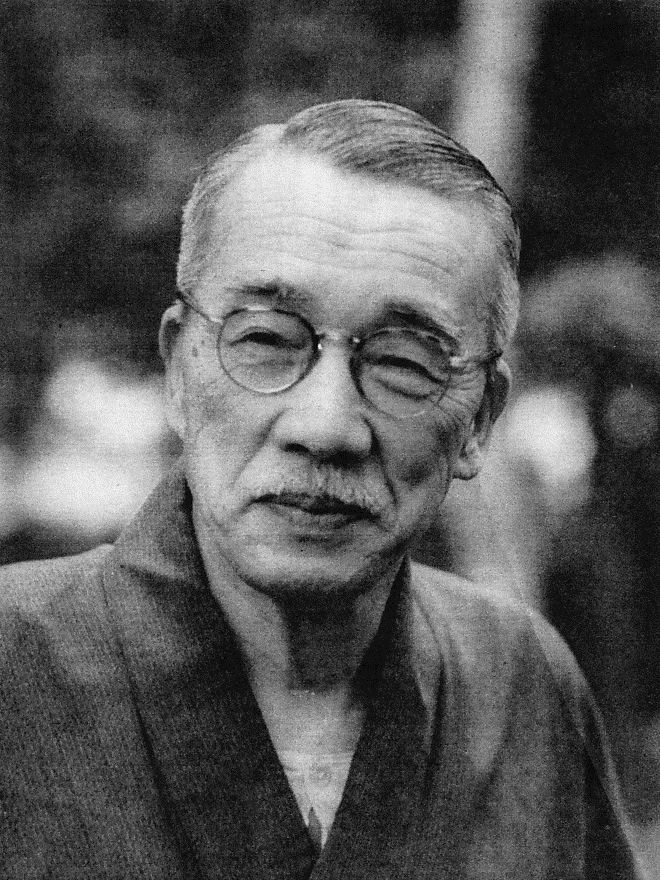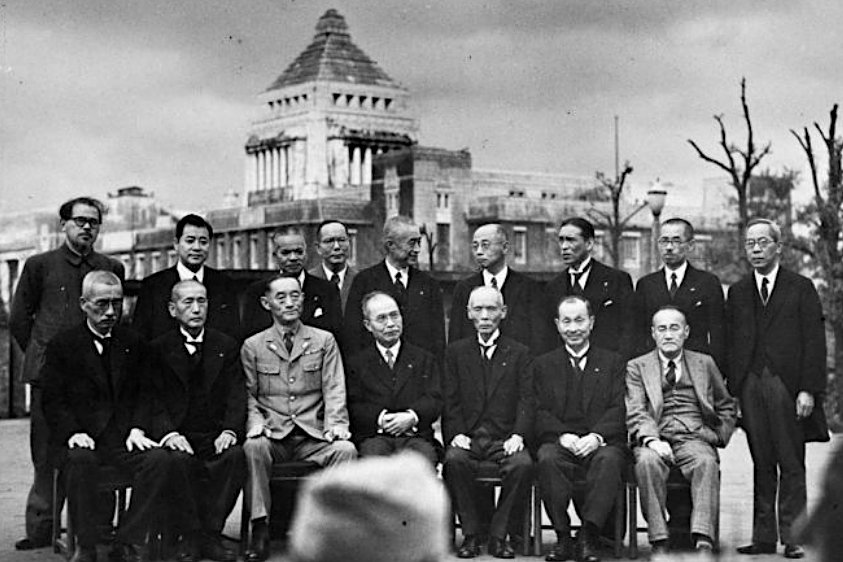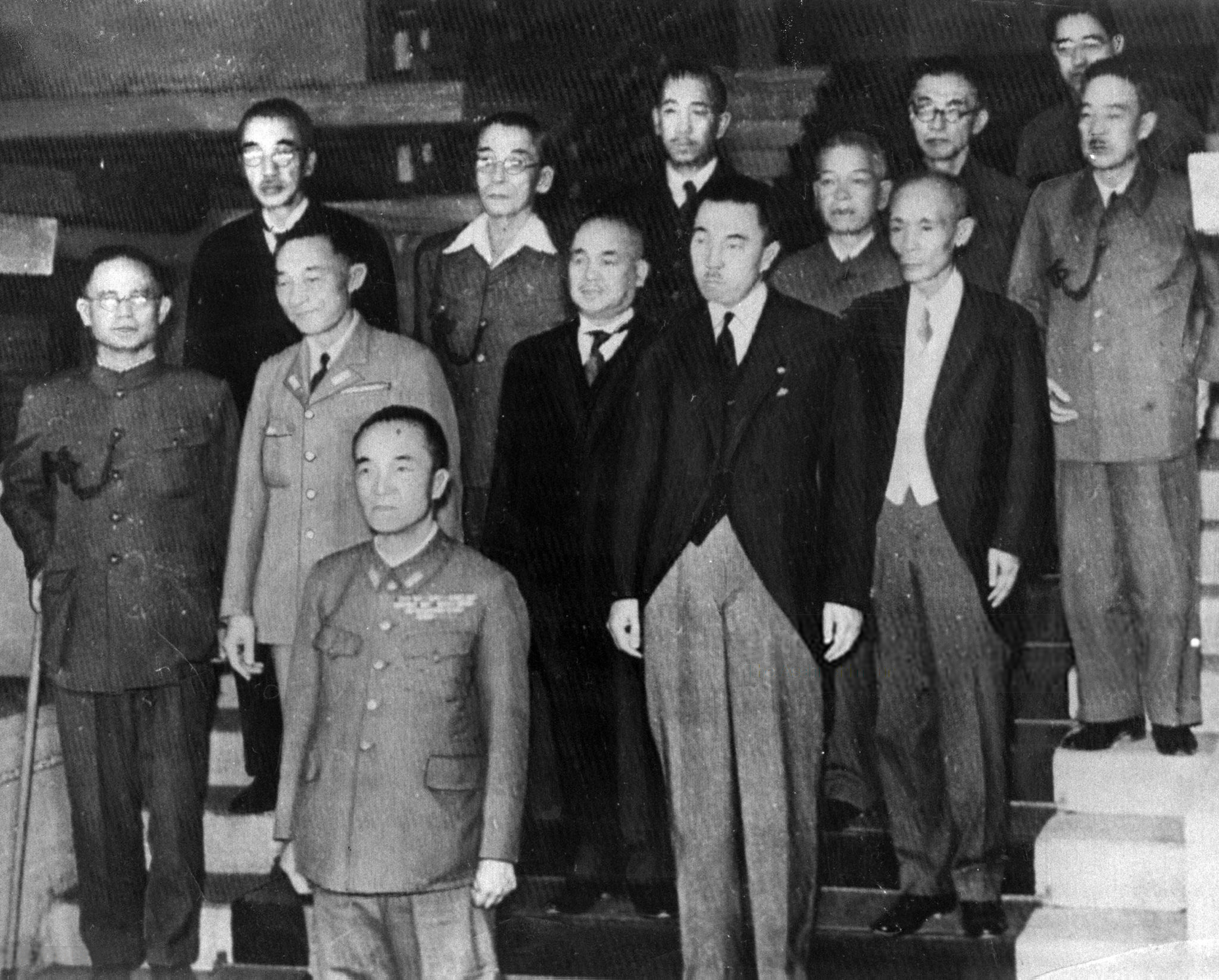|
Kenzō Matsumura
was a Japanese politician in the prewar and postwar periods, serving stints in the cabinet as Minister of Health, Labour, and Welfare, Minister of Health and Welfare, Ministry of Agriculture and Forestry (Japan), Minister of Agriculture and Forestry, and Minister of Education (Japan), Minister of Education. Matsumura is remembered for his mastery of arcane details of Japanese agricultural policy, as well as for, in his later years, his tireless efforts to normalize Japanese diplomatic and trade relations with China, which he viewed as essential for Japan to chart a course on the international stage more independent from the United States. Early life and education Kenzō Matsumura was born on January 24, 1883, in Nishinami district, Fukumitsu, Toyama, Fukumitsu, Toyama prefecture, the eldest son of a wealthy landowner who ran an apothecary shop. His biological mother left the family for unknown reasons when he was two years old and he was raised by his stepmother, alongside a h ... [...More Info...] [...Related Items...] OR: [Wikipedia] [Google] [Baidu] |
Minister Of Education (Japan)
The , also known as MEXT, is one of the eleven ministries of Japan that compose part of the executive branch of the government of Japan. History The Meiji government created the first Ministry of Education in 1871. In January 2001, the former Ministry of Education, Science, Sports and Culture and the former merged to become the present MEXT. Organization The Ministry of Education, Culture, Sports, Science and Technology currently is led by the minister of education, culture, sports, science and technology. Under that position is two state ministers, two parliamentary vice-ministers, and administrative vice-minister, and two deputy ministers. Beyond that the organization is divided as follows. Minister's Secretariat The Minister's Secretariat is the department that manages general policies that affect the Ministry of Education, Culture, Sports, Science and Technology as a whole. These functions include many administrative jobs such as auditing policies, community relations ... [...More Info...] [...Related Items...] OR: [Wikipedia] [Google] [Baidu] |
Ministry Of Agriculture And Forestry (Japan)
Ministry of Agriculture and Forestry may refer to: * Ministry of Agriculture and Forestry (Alberta), in the Executive Council of Alberta, Canada * Ministry of Agriculture and Forestry (Bulgaria), now the Ministry of Agriculture, Food and Forestry * Ministry of Agriculture and Forestry (Equatorial Guinea) * Ministry of Agriculture and Forestry (Finland) * Ministry of Agriculture and Forestry (Japan), now the Ministry of Agriculture, Forestry and Fisheries * Ministry of Agriculture and Forestry (Kaduna State), Nigeria, now the Ministry of Agriculture * Ministry of Agriculture and Forestry (Laos) * Ministry of Agriculture and Forestry (New Zealand), now defunct and part of the Ministry for Primary Industries * Ministry of Agriculture and Forestry (South Korea), now the Ministry for Food, Agriculture, Forestry and Fisheries * Ministry of Agriculture and Forestry (South Sudan) * Ministry of Agriculture and Forestry (Turkey) See also * List of agriculture ministries * List of for ... [...More Info...] [...Related Items...] OR: [Wikipedia] [Google] [Baidu] |
Orchid
Orchids are plants that belong to the family Orchidaceae (), a diverse and widespread group of flowering plants with blooms that are often colourful and fragrant. Orchids are cosmopolitan plants that are found in almost every habitat on Earth except glaciers. The world's richest diversity of orchid genera and species is in the tropics. Orchidaceae is one of the two largest families of flowering plants, the other being the Asteraceae. It contains about 28,000 currently accepted species in 702 genera. The Orchidaceae family encompasses about 6–11% of all species of seed plants. The largest genera are '' Bulbophyllum'' (2,000 species), '' Epidendrum'' (1,500 species), '' Dendrobium'' (1,400 species) and '' Pleurothallis'' (1,000 species). It also includes '' Vanilla'' (the genus of the vanilla plant), the type genus '' Orchis'', and many commonly cultivated plants such as '' Phalaenopsis'' and '' Cattleya''. Moreover, since the introduction of tropical species into cu ... [...More Info...] [...Related Items...] OR: [Wikipedia] [Google] [Baidu] |
Shiitake Mushroom
The shiitake (; ''Chinese/black mushroom'' or ''Lentinula edodes'') is a macrofungus native to East Asia, which is cultivated and consumed around the globe. Taxonomy The fungus was first described scientifically as '' Agaricus edodes'' by Miles Joseph Berkeley in 1877. It was placed in the genus '' Lentinula'' by David Pegler in 1976. The fungus has acquired an extensive synonymy in its taxonomic history: *''Agaricus edodes'' Berk. (1878) *'' Armillaria edodes'' (Berk.) Sacc. (1887) *''Mastoleucomychelloes edodes'' (Berk.) Kuntze (1891) *''Cortinellus edodes'' (Berk.) S.Ito & S.Imai (1938) *'' Lentinus edodes'' (Berk.) Singer (1941) *'' Collybia shiitake'' J.Schröt. (1886) *'' Lepiota shiitake'' (J.Schröt.) Nobuj. Tanaka (1889) *''Cortinellus shiitake'' (J.Schröt.) Henn. (1899) *'' Tricholoma shiitake'' (J.Schröt.) Lloyd (1918) *''Lentinus shiitake'' (J.Schröt.) Singer (1936) *''Lentinus tonkinensis'' Pat. (1890) *''Lentinus mellianus'' Lohwag (1918) The ... [...More Info...] [...Related Items...] OR: [Wikipedia] [Google] [Baidu] |
Occupation Of Japan
Japan was occupied and administered by the Allies of World War II from the surrender of the Empire of Japan on September 2, 1945, at the war's end until the Treaty of San Francisco took effect on April 28, 1952. The occupation, led by the American military with support from the British Commonwealth and under the supervision of the Far Eastern Commission, involved a total of nearly one million Allied soldiers. The occupation was overseen by the US General Douglas MacArthur, who was appointed Supreme Commander for the Allied Powers by the US president Harry S. Truman; MacArthur was succeeded as supreme commander by General Matthew Ridgway in 1951. Unlike in the occupations of Germany and Austria, the Soviet Union had little to no influence in Japan, declining to participate because it did not want to place Soviet troops under MacArthur's direct command. This foreign presence marks the only time in the history of Japan that it has been occupied by a foreign power. Howe ... [...More Info...] [...Related Items...] OR: [Wikipedia] [Google] [Baidu] |
Purge (occupied Japan)
Following Japan's defeat in World War II, the Allied Occupation of Japan ordered the purge of tens of thousands of designated persons from public service positions. Individuals targeted in the purge included accused war criminals, military officers, leaders of ultranationalist societies, leaders in the Imperial Rule Assistance Association, business leaders involved in Japanese overseas economic expansion, governors of former Japanese colonies, and national leaders involved in the decisions leading Japan into war. Ultimately, SCAP screened a total of 717,415 individuals, and banned 201,815 of them from holding public office. However, as part of the "Reverse Course" in Occupation policy, most of the purgees would be de-purged and allowed to return to public life by 1951. This purge of conservative elements during the Occupation is sometimes retroactively referred to as the "White Purge" to distinguish it from a similar " Red Purge" of communists and leftists. General descriptions ... [...More Info...] [...Related Items...] OR: [Wikipedia] [Google] [Baidu] |
Shidehara Cabinet
The Shidehara Cabinet is the 44th Cabinet of Japan led by Kijūrō Shidehara Baron was a Japanese diplomat and politician who served as prime minister of Japan from 1945 to 1946. He was a leading proponent of pacifism in Japan before and after World War II. Born to a wealthy Osaka family, Shidehara studied law at Tok ... from 9 October 1945 to 22 May 1946, during the Allied occupation. Cabinet Reshuffled Cabinet A Cabinet reshuffle took place on January 13, 1946. References {{Cabinets of Japan Cabinet of Japan 1945 establishments in Japan Cabinets established in 1945 Cabinets disestablished in 1946 Cabinets of the Empire of Japan 1946 disestablishments in Japan ... [...More Info...] [...Related Items...] OR: [Wikipedia] [Google] [Baidu] |
Higashikuni Cabinet
The Higashikuni Cabinet is the 43rd Cabinet of Japan led by Prince Naruhiko Higashikuni from August 17 to October 9, 1945. The Allied occupation began on 28 August 1945 following the surrender of Japan. The Cabinet's principal task was to preserve the integrity of the Japanese government in the chaotic aftermath of the Kyūjō incident and oversee the disbanding of the Imperial Japanese Army and Navy. Following a dispute with Allied commanders over the repeal of the Peace Preservation Law, the Cabinet resigned on 9 October and was succeeded by the Shidehara Cabinet The Shidehara Cabinet is the 44th Cabinet of Japan led by Kijūrō Shidehara Baron was a Japanese diplomat and politician who served as prime minister of Japan from 1945 to 1946. He was a leading proponent of pacifism in Japan before and af .... Cabinet References {{Cabinets of Japan Cabinet of Japan 1945 establishments in Japan Cabinets established in 1945 Cabinets disestablished in 1945 Cabine ... [...More Info...] [...Related Items...] OR: [Wikipedia] [Google] [Baidu] |
Imperial Rule Assistance Political Association
The , abbreviated to ''Yokuseikai'' or IRAPA, was the policymaking body set up within the Imperial Rule Assistance Association for the purpose of liaising between the IRAA and the National Diet, and consisted of a joint caucus of members of both the House of Representatives and the House of Peers. The IRAPA existed between 20 May 1942 and 30 March 1945, when the IRAA collapsed amid political infighting that attended the drastically worsening war situation. In Japanese history, the Imperial Rule Assistance Political Association established the " one country, one party" system. History Although candidates who received the endorsement of the IRAA and its affiliated Imperial Rule Assistance Young Men's Corps won a commanding majority in the elections of 30 April 1942, 85 unendorsed candidates who were critical of Prime Minister Hideki Tojo’s cabinet were also elected. Tojo, who was concerned about this, invited 70 representatives from the political world, the business commun ... [...More Info...] [...Related Items...] OR: [Wikipedia] [Google] [Baidu] |
Imperial Rule Assistance Association
The , or Imperial Aid Association, was the Empire of Japan's ruling political organization during much of the Second Sino-Japanese War and World War II. It was created by Prime Minister Fumimaro Konoe on 12 October 1940, to promote the goals of his ("New Order") movement. It evolved into a statist, para-fascist ruling political party which aimed at removing sectionalism and factionalism from politics and economics in the Empire of Japan, creating a totalitarian one-party state in order to maximize the efficiency of Japan's total war effort against China and later the Allies. When the organization was launched officially, Konoe was hailed as a "political savior" of a nation in chaos; however, internal divisions soon appeared. Origins Based on recommendations by the , Konoe originally conceived of the Imperial Rule Assistance Association as a reformist political party to overcome the deep-rooted differences and political cliques between bureaucrats, politicians and ... [...More Info...] [...Related Items...] OR: [Wikipedia] [Google] [Baidu] |
Hiranuma Cabinet
The Hiranuma Cabinet is the 35th Cabinet of Japan led by Hiranuma Kiichirō from January 5, 1939, to August 30, 1939. The cabinet had to contend and enforce the mobilization of Japan's economic resources for total war started under his predecessor, Fumimaro Konoe who passed the State General Mobilization Law. The Hiranuma Cabinet was formed as a result of the collapse of Konoe's first premiership, who had resigned over his failure to negotiate an end to the Second Sino-Japanese War after breaking off relations with the Nationalist government The Nationalist government, officially the National Government of the Republic of China, refers to the government of the Republic of China (1912–1949), Republic of China from 1 July 1925 to 20 May 1948, led by the nationalist Kuomintang (KMT .... Cabinet Notes References {{Cabinets of Japan Cabinet of Japan 1939 establishments in Japan Cabinets established in 1939 Cabinets disestablished in 1939 Cabinets of the Empir ... [...More Info...] [...Related Items...] OR: [Wikipedia] [Google] [Baidu] |
Constitutional Democratic Party (Japan)
was one of the main political parties in pre-war Empire of Japan. It was commonly known as the ''Minseitō''. History The ''Minseitō'' was founded on 1 June 1927, by a merger of the ''Kenseikai'' and the ''Seiyu Hontō'' political parties. Its leadership included Hamaguchi Osachi, Wakatsuki Reijirō, Yamamoto Tatsuo, Takejirō Tokonami, Adachi Kenzō, Koizumi Matajirō and Saitō Takao. The party platform was politically and economically more liberal than its major rival, the ''Rikken Seiyūkai,'' calling for rule by the Diet of Japan rather than bureaucrats or ''genrō,'' elimination of disparities in wealth, international cooperation, and protection of personal liberties. The ''Minseitō'' fielded many candidates in the February 1928 General Election, (the first to be held after the General Election Law), winning 217 seats in the Lower House, as opposed to 218 seats for the ''Seiyūkai''. This resulted in a hung parliament. In the following 1930 General Election, th ... [...More Info...] [...Related Items...] OR: [Wikipedia] [Google] [Baidu] |






